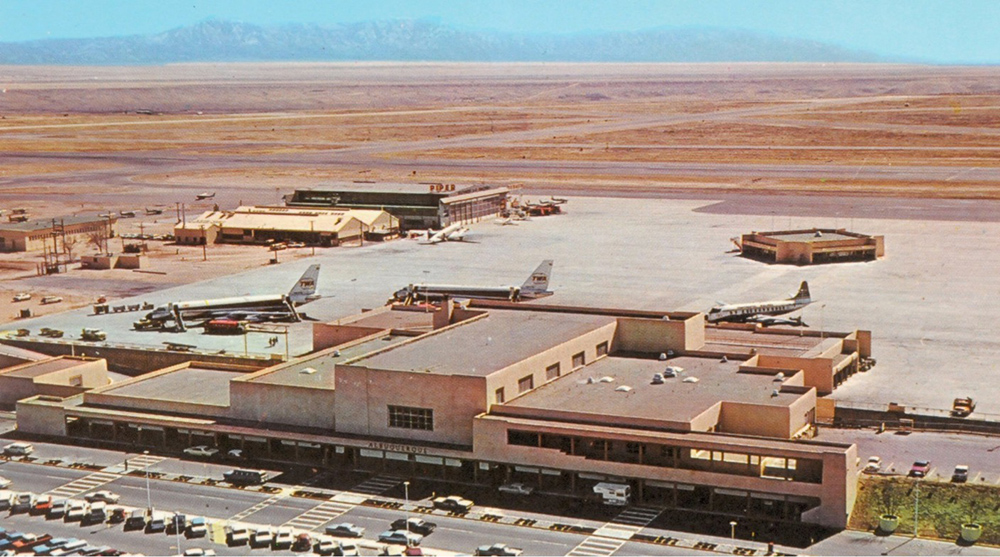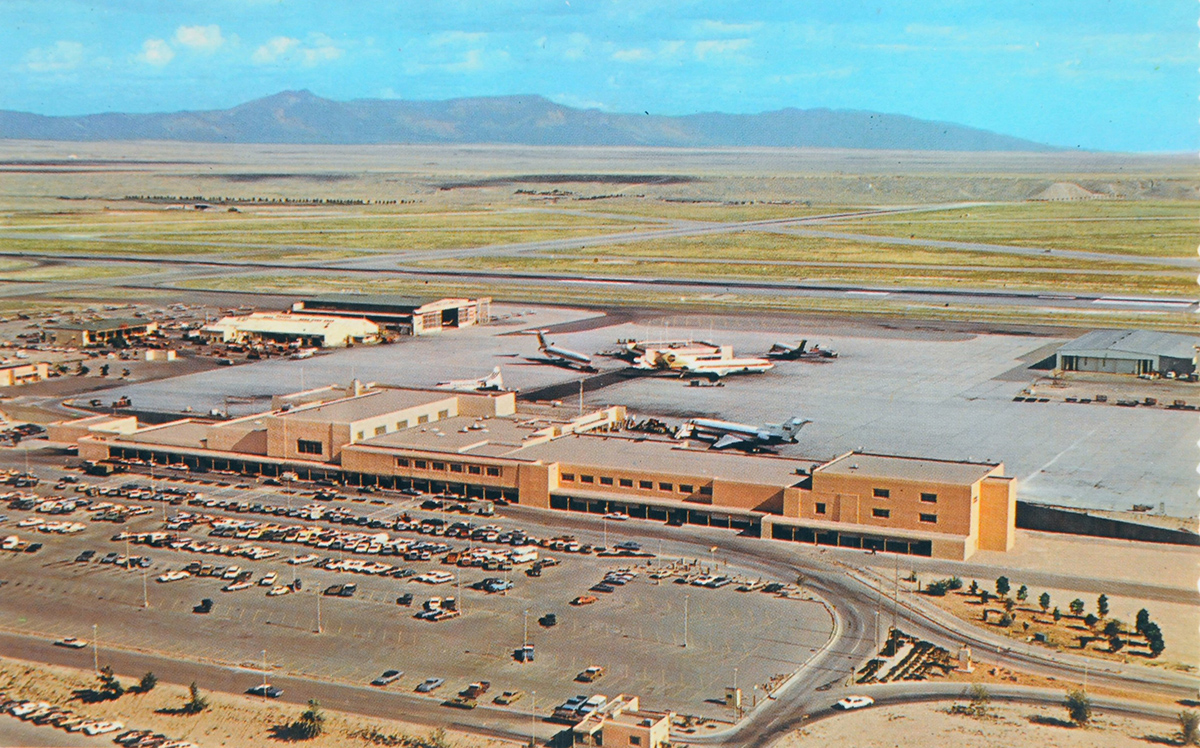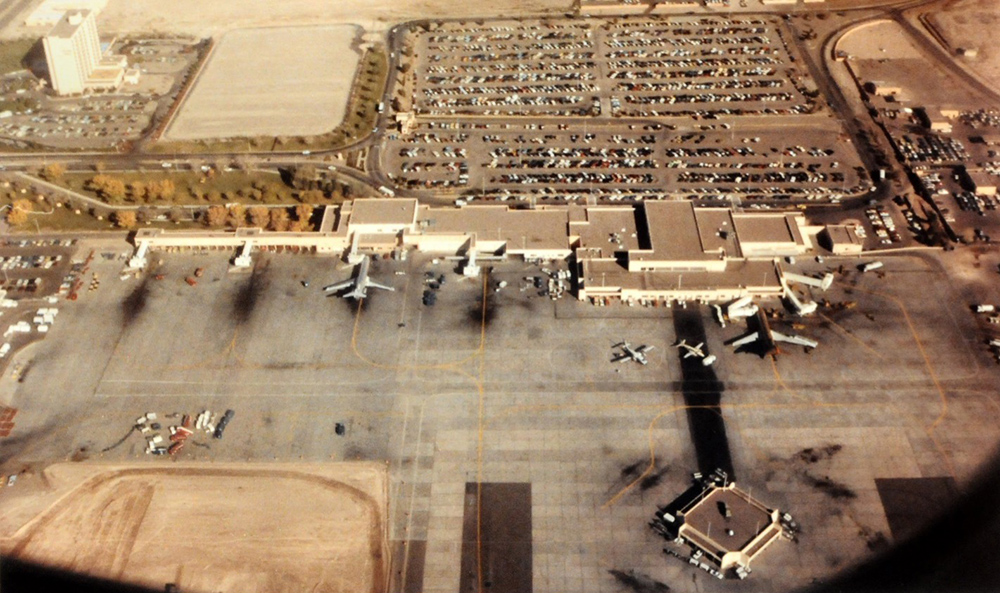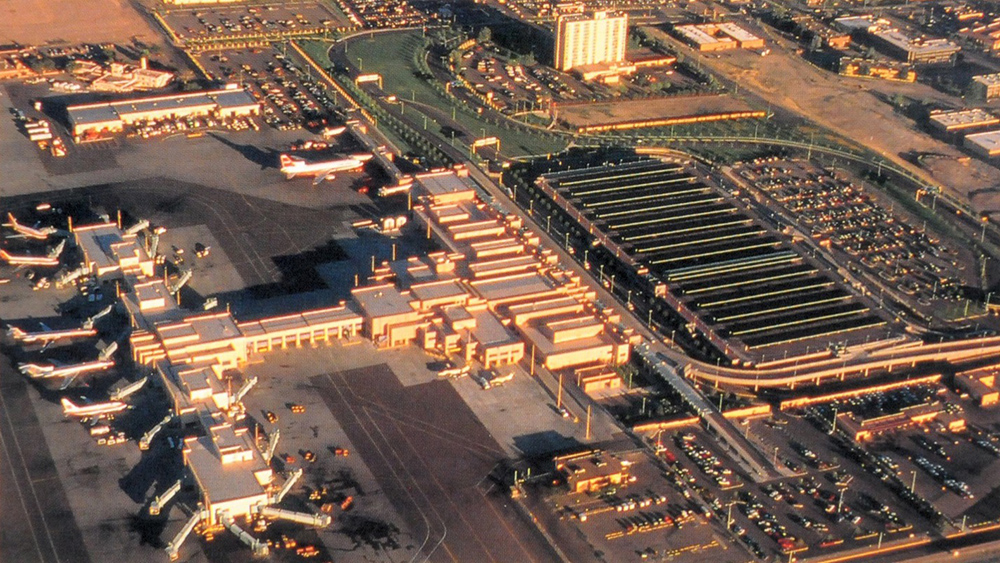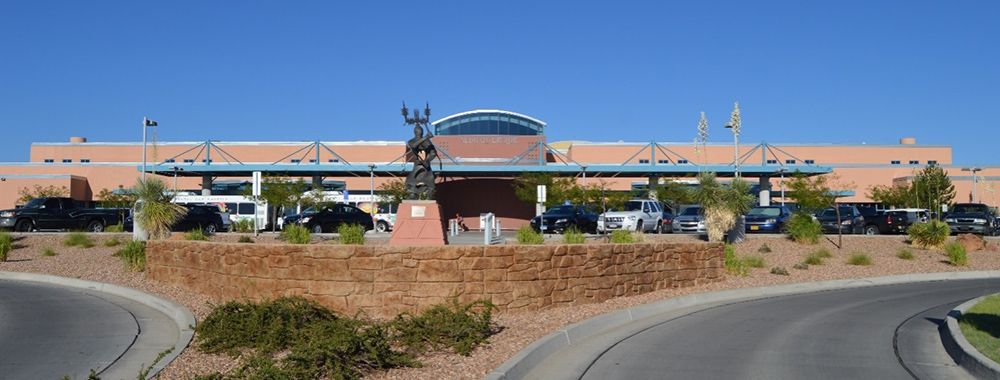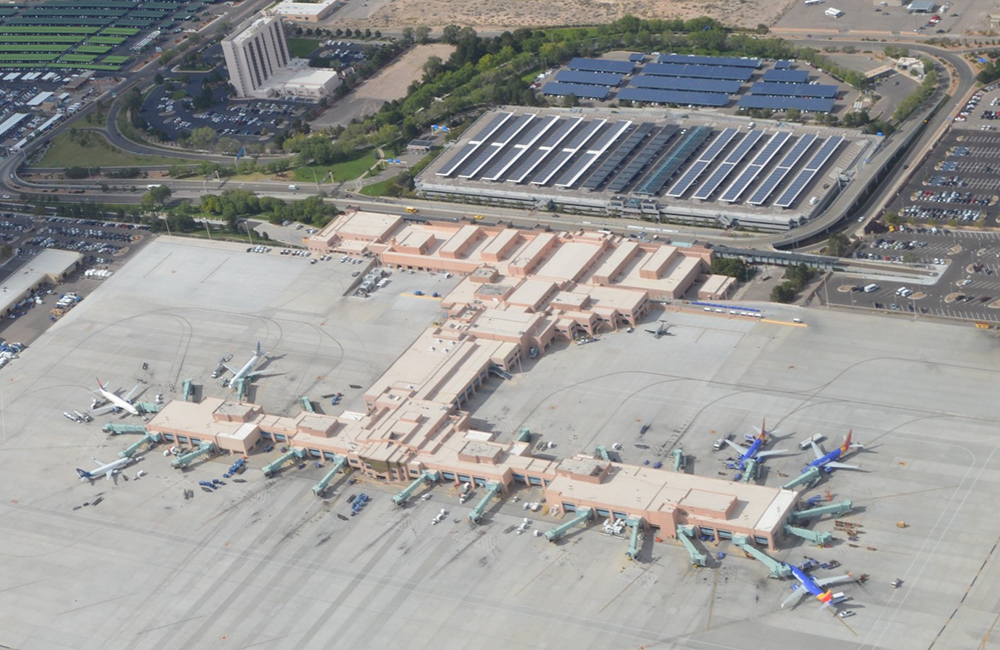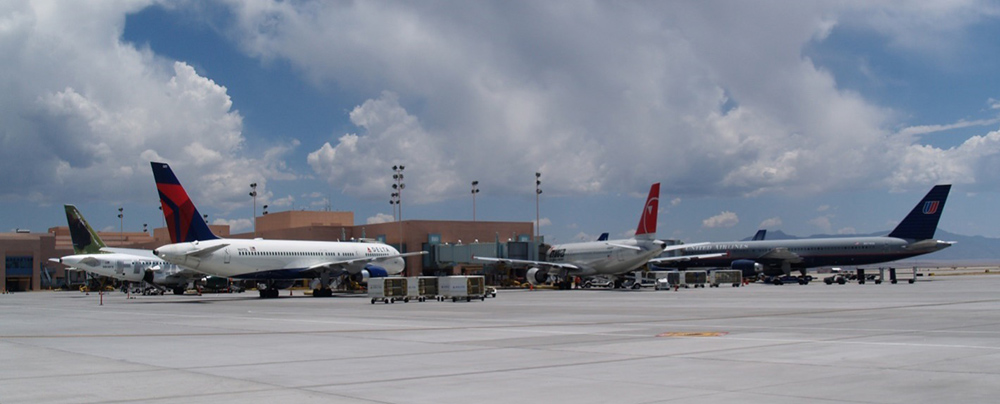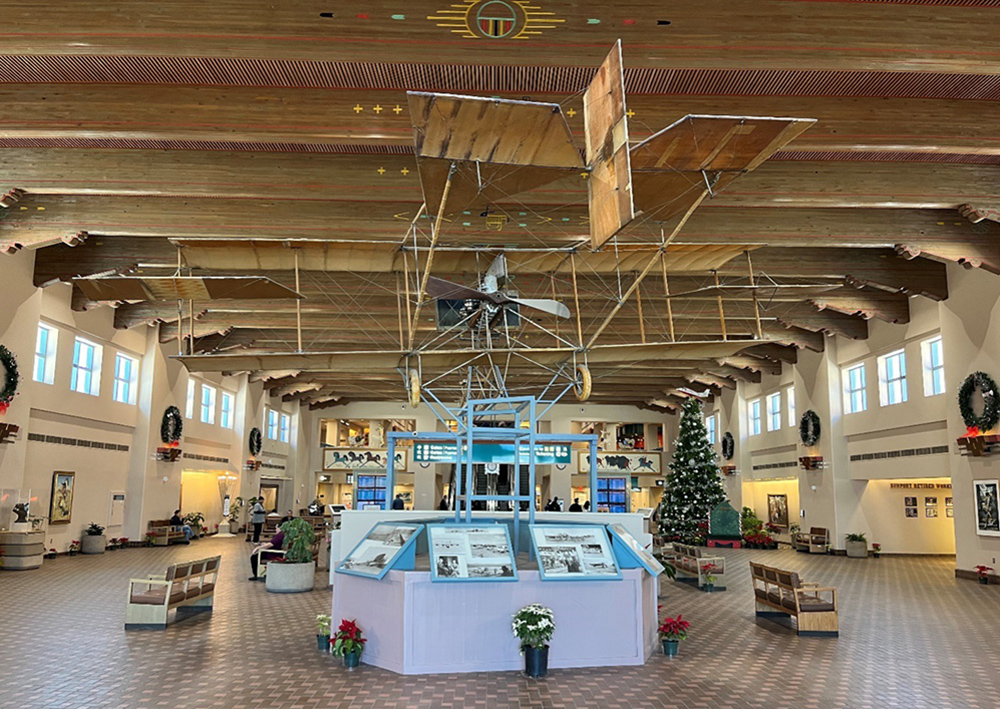Albuquerque Airport
Albuquerque International Sunport 1965-today
By the early 1960’s the original Albuquerque Municipal Airport terminal of 1939 was well outgrown and a decision was made to build a new and much larger terminal a short distance to the east. The new $2.5 million terminal, designed by architect William E. Burk, opened on November 12, 1965 containing five airline ticket counters and eight gates. Four of the gates were located in the main building while the other four were at a small satellite building directly south and connected to the main terminal by a tunnel that went underneath the aircraft apron. All gates were ground level and none had jetbridges. The new terminal also had a public, open air, roof top observation area which was common and very popular at airports during that era. Continental Airlines reintroduced jet service to the airport in 1966 with the Douglas DC-9 followed soon by the Boeing 727.
One year later Frontier began jet service with 727’s and Trans-Texas with DC-9’s. In 1969 each of these three carriers began flying new nonstop flights with their jets to cities such as Chicago, Dallas, Denver, Las Vegas, Los Angeles, and San Francisco, several of which were previously only flown by TWA. TWA also added up to ten new flights per day on its routes. U.S. Customs facilities were added into the old terminal in 1971 and the Sunport was renamed “Albuquerque International Airport” on September 27, 1971 although it would continue to be referred to as the Sunport.
Several expansions have since been built onto the new terminal, the first in 1973 with the creation of a west wing that contained one larger gate with a jetbridge able to handle new wide-body jumbo jets. The ground level of the west wing was also used as two gates. TWA introduced the first wide-body jet to ABQ in 1974 with a Lockheed L-1011 requiring use of the west wing jetbridge gate however the flight was downgraded back to a narrow body aircraft in the beginning of 1975. The customs facilities were moved into the west wing when Frontier Airlines began providing the first international flights to Mexico in 1979. The original hanger constructed in 1939 with the first terminal, was located in the ramp space needed for the west wing so the hanger was moved to a point on the south side of the main east-west runway in 1970. An 18-story hotel opened in 1973 on the northwest corner of the airport property originally called the Airport Marina Hotel and has since gone through several ownership changes. A Marriott Flight Kitchen opened in the mid-1970’s to prepare and cater meals for airline flights. And a new cargo building opened on the west side of the terminal ramp in 1977.
Up until 1978 the airlines were regulated by the Civil Aeronautics Board and were rarely permitted to begin new routes. American, Delta, Western, and Hughes Airwest had all been applying to serve the Sunport but none were ever granted authority. That all changed on October 24, 1978 when the Airline Deregulation Act was passed allowing airlines to freely begin new routes and serve new cities as well as discontinue routes that were no longer beneficial to them. Within the first year and a half, Albuquerque quickly saw new service by three new airlines while TWA added several new routes and created a mini-hub at ABQ. The west wing was further expanded in 1980 with three additional gates, all with jetbridges. TWA entered a 25-year lease for use of all four west wing gates however the mini-hub did not prove successful and was scaled back within the first year. The new gates were then sub leased to American and a number of other new airlines that began serving the airport over the next few years.
As the terminal was flooded with new airlines in the early 1980s, space at the 12 gates was at a premium and Southwest Airlines added three ground level jetbridges to two gates at the main terminal. The smaller commuter airlines were moved to the old terminal for a short time in 1980. After the west wing was expanded, the commuters were moved back to the main terminal. New airlines had to lease space and share ticket counters with existing carriers while aircraft had to be doubled up at the four gates in the satellite building which all remained at ground level. With all the new airlines and competition, the four original carriers had to scale back and focus primarily on only serving their major hub cities from ABQ. Texas International merged into Continental Airlines in 1982 and Frontier Airlines had gone bankrupt and shut down in 1986.
From April, 1987 through June, 1989 the terminal underwent a massive $120 million expansion and renovation creating separate levels for arriving and departing passengers. The four-gate satellite building was replaced with two concourses containing 19 new gates, all with jetbridges. The four gates at the main terminal were converted for use by the commuter airlines and one of the four gates on the west wing had to be decommissioned. In all, the terminal was expanded to 485,000 square feet and provided 22 gates with jetbridges. In order to accommodate the terminal expansion, two general aviation hangers, Cutter and Southwest Air Rangers, were torn down and a whole new general aviation facility was constructed on the opposite side of the main east-west runway by 1984. Cutter Aviation first began with the original Albuquerque Airport in 1928 and moved to the current airport in 1947. A new four-level parking garage was also constructed in front of the terminal where an old ground level parking lot had been. In 1992 a new cargo facility was opened just south of the new general aviation area and all cargo aircraft operations were relocated from the old cargo building on the west end of the terminal ramp. A new post office also opened near the old terminal.
After TWA’s brief introduction with the Lockheed L-1011 aircraft in 1974, the carrier made a return of wide body service from 1982 through 1992 using both the L-1011 and the newer Boeing 767. These were the only commercial wide body jumbo jets to have served ABQ on a regular scheduled basis. The mid-1990’s saw several charter airlines from Mexico provide regular service to Mazatlan during spring break of each year. In 1994, the airport was renamed once again to its current designation as the “Albuquerque International Sunport”. Runway 3-21 was widened and extended to 10000 feet in 1995 providing a third major runway for large jet aircraft. In 1997, Sunport Boulevard was extended directly west of the terminal to provide direct access to the airport from Interstate 25. As Southwest Airlines was growing rapidly and building a hub at ABQ, the “A” concourse was extended in 1996 adding four more gates. By 2001, Southwest was operating 66 daily departures. The “B” concourse was also designed for possible extension but it does not appear that it will be needed anytime soon. TWA was the only carrier to remain operating at the west wing after the terminal expansion was completed in 1989 however the airline moved to the B concourse in the mid-1990’s which left the west wing, re-designated as the C concourse, now empty. In the late 1990’s, a new food court was constructed at the T-junction between the two concourses and an observation lounge was erected on the level above it. In January, 2001, a new off-site rental car facility opened which relocated all rental car operations out of the main terminal.
The 2000’s millennium started off with a downfall in traffic after the 9/11 terrorist attacks. 2001 also saw TWA, the grandfather airline of Albuquerque, merge into American Airlines ending more than 72 years of TWA service to the city. In 2005, the connector building leading to the two concourses was widened to provide additional space for more enhanced security screening which brought the overall operating space at the terminal to 600,000 square feet. This expansion did require the dismantling of one gate on the “B” concourse. Two gates on the west wing incurred structural failure and were dismantled in 2007 leaving the west wing with only the one gate that was originally built in 1973. The 2000’s decade also saw new smaller regional jets (RJ’s) become very popular amongst the larger airlines. These jets only hold 50 to 76 passengers and, at times, all fights by a particular larger airline, such as United, were operated with RJ’s. These jets provide more frequency on routes and opened up new routes that could not support larger jets. As all the airlines are now operating from the 22 gates on the two concourses, the isolated remaining gate on the west wing, which houses U. S. Customs, is only used for occasional international charter or diverted flights. ABQ has briefly seen scheduled international flights on three occurrences since 2008. Commuter airline traffic greatly declined during the early 2000’s which led to one of the two commuter gates on the non-secure side of the terminal to be closed. A massive repaving of the entire terminal ramp area was performed in 2007 and 2008 replacing the asphalt areas with all concrete.
2007 was a banner year for the Sunport handling nearly 6.7 million passengers however the nations economy then went into a recession and several airlines, particularly Southwest, the Sunport’s busiest carrier, began scaling back on its flights, many to short haul destinations such as Amarillo, El Paso, and Tucson. Several other cities in New Mexico, such as Santa Fe and Roswell, were able to improve their own air service when nonstop regional jet service was introduced to large hubs such as Dallas/Fort Worth, Denver, and Phoenix operated by American Eagle and United Express. Passengers from around New Mexico no longer had to rely on coming to Albuquerque for their air service needs. Southwest Airlines had also used ABQ as a connecting point for passengers travelling west from their base at the Dallas Love Field airport. Love Field was restricted by a ruling called the Wright Amendment which only allowed airlines to fly from Dallas to cities in states that bordered Texas. This ruling was lifted in 2014 allowing Southwest to overfly ABQ for flights destined to larger cities in the west. Several other large airlines merged between 2007 and 2012 ultimately resulting in some loss of service. Of these mergers included Continental Airlines which had served Albuquerque since 1934 and merged into United in 2012. As a result of these factors, the Sunport saw a decline in passengers to 4.75 million in 2015, a nearly 30 percent drop since 2007.
The Sunport then began rebounding, attracting some new airlines while other carriers began to upgrade select flights from regional aircraft back to larger mainline jets. The terminal received a major facelift with a renovation project between 2017 and 2020, thirty years after the massive expansion had been completed. Traffic had built up to 5.5 million passengers in 2018 but then a new series of setbacks begin to take place. In 2019, the newest generation Boeing 737 Max aircraft was grounded after technical complications. Southwest, American, and United Airlines all had many of these aircraft in service and were forced to discontinue several flights at ABQ. The following year literally saw the bottom fall out when the Covid-19 pandemic struck causing a 96 percent drop in air travel nationwide. Altogether, the airlines at ABQ cut back to less than 20 flights per day in April of 2020, most of which still carried very few passengers. It would be a very slow recovery process, one that led up to a significant labor shortage by the end of 2021, particularly with pilots and other airline employees as many had retired or left the airlines while they were not working during the pandemic. The 737 Max aircraft had returned to fly but it would be more than three years before the Sunport had regained most of the airline flights lost by the pandemic. In early 2023, the Sunport kicked off another massive project to move the security checkpoint further up in the terminal and create a new arcade of shops and restaurants where the checkpoint is currently located. This $85 million project is expected to take three years to complete.
Since airline deregulation occurred in 1978, ABQ has been served by Eastern, Western, Northwest, America West, PSA, USAir/US Airways, PanAm, Braniff, Wien Air Alaska, Reno Air, Western Pacific, ExpressJet, Allegiant, and a second Frontier Airlines along with international service by AeroMexico and Volaris. With all the airline mergers and failures, Albuquerque is now down to only four major carriers once again; American, Delta, Southwest, and United, along with limited service by Alaska, jetBlue, and Spirit Airlines. Sun Country Airlines plans to begin seasonal service in the summer of 2024. Several other regional carriers operate as American Eagle, Delta Connection, United Express, and Alaska Horizon on behalf of their major airline partners. More than 40 smaller commuter and regional airlines have also served the airport over the years. Mesa Airlines was the largest of the commuters and served ABQ from 1980 through 2007 with as many as 46 daily flights to cities throughout New Mexico and Colorado including flights every hour to Farmington and Roswell. Mesa has since grown with regional jets and now serves ABQ as United Express. The only commuter now serving the Sunport is Advanced Air which only flies to Carlsbad, Las Cruces, and Silver City in New Mexico as these routes are subsidized by either the federal government under the Essential Air Service (EAS) program or by the State of New Mexico. There are no longer any flights from Albuquerque to Farmington or Roswell. The Sunport also receives regular air cargo service by FedEx, UPS, Amazon Prime Air, and Ameriflight which is a feeder carrier for DHL. Sun Country Airlines frequently operates charter flights through ABQ while the fixed base operators, Cutter and Atlantic Aviation, frequently serve private charter companies including NetJets and FlexJet. Overall, in 1970 ABQ had about 75 departures per day amongst all the airlines. By 1995 that figure more than doubled to 163 per day but the number has fallen back to 75 per day again in 2023 including 33 on Southwest. There are 21 cities served nonstop from ABQ on a year round basis, three cities having service to two different airports, plus five more cities with nonstop service on a seasonal basis. Historically, the Sunport has seen nonstop service to 75 destinations, many of which were smaller cities within New Mexico.
The Sunport has a large art collection on display including this piece by local native artist Pop Chalee. Miss Chalee was chosen by Howard Hughes in the 1940’s to have her murals displayed in the original terminal.
Some notable events that have occurred at the Albuquerque International Sunport include:
- On February 19, 1955, A TWA Martin 404 aircraft on a flight to Santa Fe crashed into the Sandia Mountains on a cloudy day killing all 16 people aboard. A faulty compass was determined to be the cause.
- In 1956, the Duke and Duchess of Alburquerque, Spain visited Albuquerque, New Mexico for the cities 250th anniversary arriving on a TWA Super Constellation.
- On November 27, 1971, a TWA Boeing 727 that had departed for Chicago was hijacked to Cuba and a few months later a Frontier Airlines flight bound for Tucson was also hijacked. As airline hijackings were becoming all too common around the world, security check points were implemented in 1972.
- On November 3, 1973 a DC-10 jumbo jet while on a flight from Houston to Las Vegas incurred an engine explosion about 100 miles southwest of ABQ. One window was shattered and one passenger was sucked out of the aircraft by the resulting cabin decompression. The aircraft was able to make a safe emergency landing at ABQ with no further fatalities. In 2018 a nearly identical incident happened to a commercial airliner while cruising over Pennsylvania in which one passenger was partially sucked out of a broken window but fellow passengers were able to hold her back. That crippled aircraft was able to make a safe landing at Philadelphia but unfortunately the injured passenger later died. Ironically, that passenger was from Albuquerque.
- Many movie scenes have been filmed at ABQ over the years. Outrageous Fortune, filmed in 1986, contains several scenes of the airport as it was just prior to the major terminal expansion which began the following year.

